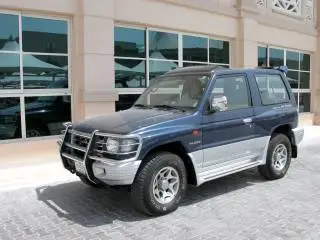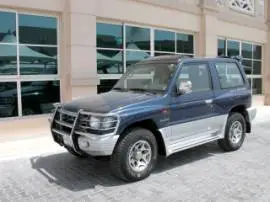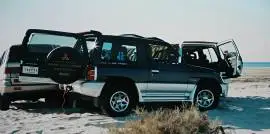2001, Mitsubishi, Pajero SWB 3.5

-
Category
-
PostedOct 21, 2025
-
Views81
Year
2001
Brand/Make
Mitsubishi
Model
Pajero SWB 3.5
Description
A Mitsubishi Pajero, driven by Andrew Cowan, finished the 1983 Paris–Alger–Dakar as the winner in class with another teammate George Debussy coming second in class and 14th overall after covering more than 11,000 km, beginning the Pajero's Dakar Rally legacy.
Mitsubishi competed primarily in the Modified Production Class (T2) category. Contrary to popular belief, T2 vehicles are almost identical to those sold to the public.
Mitsubishi dominated with multiple first, second and third place podium finishes across the T2 and T3 categories beginning in 1983 until their final wins in 2007. Their overall record was 12 total overall wins (1st place) in the "Cars Class" and 150 stage wins (the second-best being Peugeot with only 78 stage wins in comparison). Mitsubishi earned the title of ‘Most Dakar Rally Wins by A Manufacturer’ from the Guinness World Records.
This third generation was redesigned with a lower, wider stance and unibody (monocoque) construction with integrated ladder frame chassis for increased torsional rigidity and drastically improved cabin strength when compared to typical body-on-frame (ladder frame) designs. This was in part due to Mitsubishi's RISE reinforcement system which resulted in a chassis and body combination that exhibited impressive structural integrity in rollover accidents and was completely unaffected by severe chassis loading as would typically be experienced during off-road recoveries.
The Super Select 4 (SS4) system was also further refined. This meant the front-to-rear torque setting ranged from 33:67, with the ability to adjust to 50:50 depending on surface conditions. The system was also made fully electronic, meaning the vehicle didn't have to be in gear to switch between drive modes.
Mitsubishi competed primarily in the Modified Production Class (T2) category. Contrary to popular belief, T2 vehicles are almost identical to those sold to the public.
Mitsubishi dominated with multiple first, second and third place podium finishes across the T2 and T3 categories beginning in 1983 until their final wins in 2007. Their overall record was 12 total overall wins (1st place) in the "Cars Class" and 150 stage wins (the second-best being Peugeot with only 78 stage wins in comparison). Mitsubishi earned the title of ‘Most Dakar Rally Wins by A Manufacturer’ from the Guinness World Records.
This third generation was redesigned with a lower, wider stance and unibody (monocoque) construction with integrated ladder frame chassis for increased torsional rigidity and drastically improved cabin strength when compared to typical body-on-frame (ladder frame) designs. This was in part due to Mitsubishi's RISE reinforcement system which resulted in a chassis and body combination that exhibited impressive structural integrity in rollover accidents and was completely unaffected by severe chassis loading as would typically be experienced during off-road recoveries.
The Super Select 4 (SS4) system was also further refined. This meant the front-to-rear torque setting ranged from 33:67, with the ability to adjust to 50:50 depending on surface conditions. The system was also made fully electronic, meaning the vehicle didn't have to be in gear to switch between drive modes.
Modifications on this car
I learnt to dune-bash (drive over large sand dunes) in this car. Although it was very good in the sand, I do remember getting it stuck several times. An unusual feature was the front two seats were sprung. The ride was so harsh that Mitsubishi had to make the front seats sprung as you would in a truck. Passengers in the rear seats often complained of the harsh ride. It was a nice car to drive on the road, if you were in the front.
Vehicle Still Registered
UNSURE
Maximum Speed
115 mph
Acceleration 0-60mph
9.2 Seconds
Engine Cylinders
V6
Engine Capacity
3497 cc
Engine Power
205 HP
Engine Torque
221 lb/ft
Induction
Naturally Aspirated
Fueling Method
Injection
Fuel
 Petrol
Petrol
Transmission
Automatic
Gears
4 Speed
Drivetrain
 Front wheel drive
Front wheel drive Rear wheel drive
Rear wheel drive Four wheel drive
Four wheel drive Limited slip differential
Limited slip differential Overdrive
Overdrive


